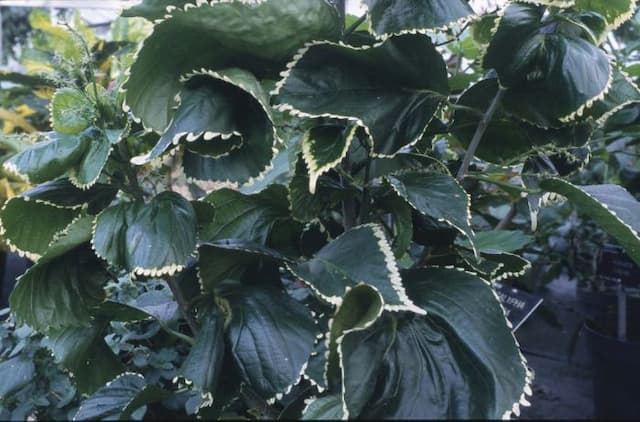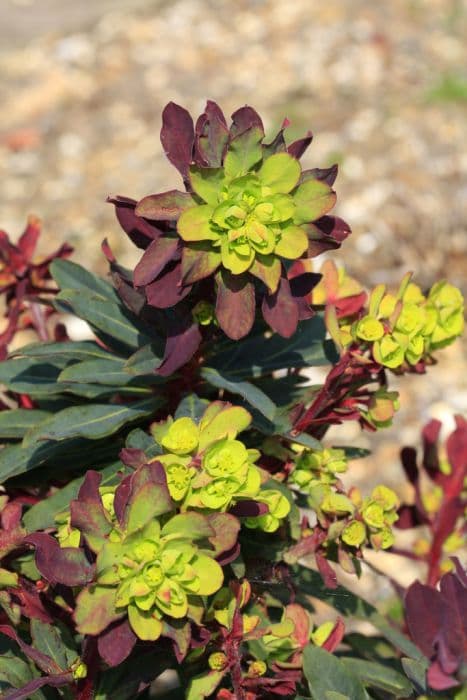Spurge [Blackbird] Euphorbia Blackbird = 'Nothowlee' (PBR)
![spurge [Blackbird]](/_next/image?url=https%3A%2F%2Fplants-admin.emdemapps.com%2Fimages%2Fplants%2F%2Fimages%2F604b535f37783.png&w=3840&q=75)
ABOUT
[Blackbird] is a dwarf evergreen sub-shrub forming a bushy mound to 50cm. The narrow leaves are green flushed with dark reddish purple, the colour deepest in good light. The flower bracts are bright yellowish green, present from early to late spring
About this plant
 Names
NamesSynonyms
Blackbird Spurge, Euphorbia 'Blackbird'.
Common names
Euphorbia 'Nothowlee' (PBR)
 Characteristics
CharacteristicsLife cycle
Perennials
Foliage type
Evergreen
Color of leaves
Purple
Flower color
Yellow
Height
1-2 feet (30-60 cm)
Spread
1-2 feet (30-60 cm)
Plant type
Shrub
Hardiness zones
7
Native area
Mediterranean
Benefits
 General Benefits
General Benefits- Attractive Foliage: Euphorbia Blackbird has striking purple-black foliage that provides visual interest and contrast in garden beds and containers.
- Drought Tolerance: Once established, this plant is highly tolerant of drought, making it suitable for water-efficient gardens.
- Low Maintenance: Requires minimal care once settled in, making it an ideal choice for busy gardeners or those looking for low-maintenance landscaping.
- Pest Resistance: It's resistant to many common plant pests, reducing the need for chemical treatments.
- Easy Propagation: Can be easily propagated from cuttings, allowing gardeners to create more plants for use around the garden or to share with others.
- Long Flowering Season: Produces distinctive yellow-green flowers over a long period, adding seasonal interest to the garden.
- Adaptable: Can thrive in a variety of soil types, provided they are well-draining.
- Suitable for Containers: Its compact size and interesting foliage make it a great choice for container planting, adding drama to patios, balconies, or other outdoor living spaces.
- Attracts Wildlife: The flowers can attract pollinators to the garden, promoting biodiversity.
- Deer Resistant: Less likely to be eaten by deer than many other garden plants, making it a good choice for gardens in deer-prone areas.
 Medical Properties
Medical PropertiesThis plant is not used for medical purposes.
 Air-purifying Qualities
Air-purifying QualitiesThis plant is not specifically known for air purifying qualities.
 Other Uses
Other Uses- Euphorbia Blackbird can be used as a natural dye for fabrics, providing a unique and organic source of color from its milky sap once properly treated and used in dyeing processes.
- Artists may use the sap and leaves to create natural inks for painting or printmaking, as the plant's components may yield interesting hues and textures.
- The striking dark purple foliage and yellow-green flowers can be used in floral arrangements to provide contrast and an exotic flair to bouquets or decorative settings.
- Consider incorporating Euphorbia Blackbird in educational settings, like schools or botanical workshops, to teach about plant forms, survival strategies, and diverse flora adaptations.
- This plant can be used as a natural pest repellent in gardens; the sap is unappealing to many herbivore insects, potentially protecting nearby plants.
- Euphorbia Blackbird's robust nature and resilience to drought make it suitable for xeriscaping and sustainable gardening practices that aim to reduce water usage.
- Use it as a photographic subject or model in art classes due to its unique aesthetic and structural form, inspiring creativity in various media.
- It can serve as a bioindicator species in garden ecosystems, as changes in the plant's health can signal shifts in local environmental conditions.
- You could use Euphorbia Blackbird as a natural fence or living wall, offering privacy and a visual barrier with its dense and colorful foliage.
- Its presence can be calming in therapeutic gardens designed for mental well-being and relaxation, contributing to a peaceful and visually engaging environment.
Interesting Facts
 Feng Shui
Feng ShuiThe Spurge is not used in Feng Shui practice.
 Zodiac Sign Compitability
Zodiac Sign CompitabilityThe Spurge is not used in astrology practice.
 Plant Symbolism
Plant Symbolism- Endurance and Perseverance - Euphorbia, commonly known as Spurge, is known for its ability to thrive in harsh conditions, symbolizing the ability to endure challenging situations and persist through adversity.
- Protection - Historically, some cultures have used Euphorbia in herbal medicine and believed it to have protective properties, potentially warding off evil spirits or negative energies.
- Purification - The sap of many Euphorbia plants has been used for cleansing and purifying, signifying the plant's association with the removal of toxicity or negative influences from one's life.
 Water
WaterThe Spurge 'Blackbird', or Euphorbia 'Blackbird', requires moderate watering, allowing the top inch of soil to dry out between waterings. Typically, this might equate to watering once every week or two depending on the environmental conditions, but this frequency may decrease during the winter months when the plant goes dormant. When you do water, thoroughly soak the soil until water runs freely from the drainage holes of the pot, ensuring that the plant receives approximately 16 to 32 ounces of water during each session. Adjust the amount based on the pot size and the season, being careful to avoid waterlogging as this can lead to root rot.
 Light
LightSpurge 'Blackbird' thrives in full sun to partial shade conditions. The ideal spot for this plant is an area where it can receive at least 6 hours of direct sunlight daily, making south or west-facing locations optimal. While it can tolerate partial shade, too little light may reduce the vibrancy of its foliage color.
 Temperature
TemperatureSpurge 'Blackbird' is a hardy plant, preferring temperatures between 60°F and 75°F, which are ideal for its growth. However, it is capable of surviving brief periods of much lower temperatures down to approximately 30°F, as well as higher temperatures as long as it is well-watered. This plant is generally hardy in USDA zones 5 through 9, making it a versatile addition to many gardens.
 Pruning
PruningPrune the Spurge 'Blackbird' in the early spring to shape the plant and to remove any dead or damaged stems, which will promote new growth and improve air circulation. Pruning can be done occasionally throughout the growing season to maintain its shape and size. The best time to perform significant pruning is shortly before new growth begins, typically just as the frost eases.
 Cleaning
CleaningNot needed
 Soil
SoilEuphorbia 'Blackbird' prefers a well-draining soil mix, combining loam, perlite, or coarse sand for drainage, and organic matter such as compost to keep the soil fertile. Ideally, the soil pH should be slightly acidic to neutral, around 6.0 to 7.0.
 Repotting
RepottingEuphorbia 'Blackbird' should be repotted every 2 to 3 years or when outgrowing its current pot. Ensure the new pot is slightly larger and has good drainage to accommodate the plant's growth.
 Humidity & Misting
Humidity & MistingEuphorbia 'Blackbird' tolerates a wide range of humidity levels but thrives best in moderate humidity conditions. Avoid excessively high humidity to prevent issues with rot or fungal diseases.
 Suitable locations
Suitable locationsIndoor
Place in a bright spot, away from direct sun.
Outdoor
Plant in full sun to partial shade, and well-drained soil.
Hardiness zone
6-9 USDA
 Life cycle
Life cycleEuphorbia Blackbird, commonly known as Spurge, begins its life cycle as a seed, germinating in warm, well-drained soil in early to mid-spring. Seedlings emerge and grow rapidly, developing into mature plants with characteristic dark purple leaves and contrasting yellow-green flowers. This perennial reaches full maturity within a few months, where it typically forms compact mounds of foliage. During the summer, the Spurge blooms and may attract pollinators, after which it may produce seeds for the next generation. As winter approaches, the plant becomes dormant, though in milder climates, some foliage may persist. With the return of warmer temperatures in spring, the cycle restarts as new growth emerges from the plant's crown or from self-sown seeds.
 Propogation
PropogationPropogation time
Spring to Summer
Euphorbia Blackbird, more commonly known as Euphorbia 'Blackbird', is typically propagated through stem cuttings. The most favorable time for propagation is in the spring or early summer when the plant is actively growing. To propagate, a gardener should select a healthy, unflowered stem and cut it to about 3 to 6 inches (approximately 7.5 to 15 cm) in length using a clean, sharp knife or pruning shears. The cut end of the stem should be allowed to dry and callous over for a couple of days to reduce the risk of rot when planted. Once calloused, the cutting can be inserted into a well-draining soil mix. The soil should be kept moist but not waterlogged to encourage root development. This method typically leads to successful propagation of the Euphorbia Blackbird, as it encourages new root growth from the cut end of the stem.









